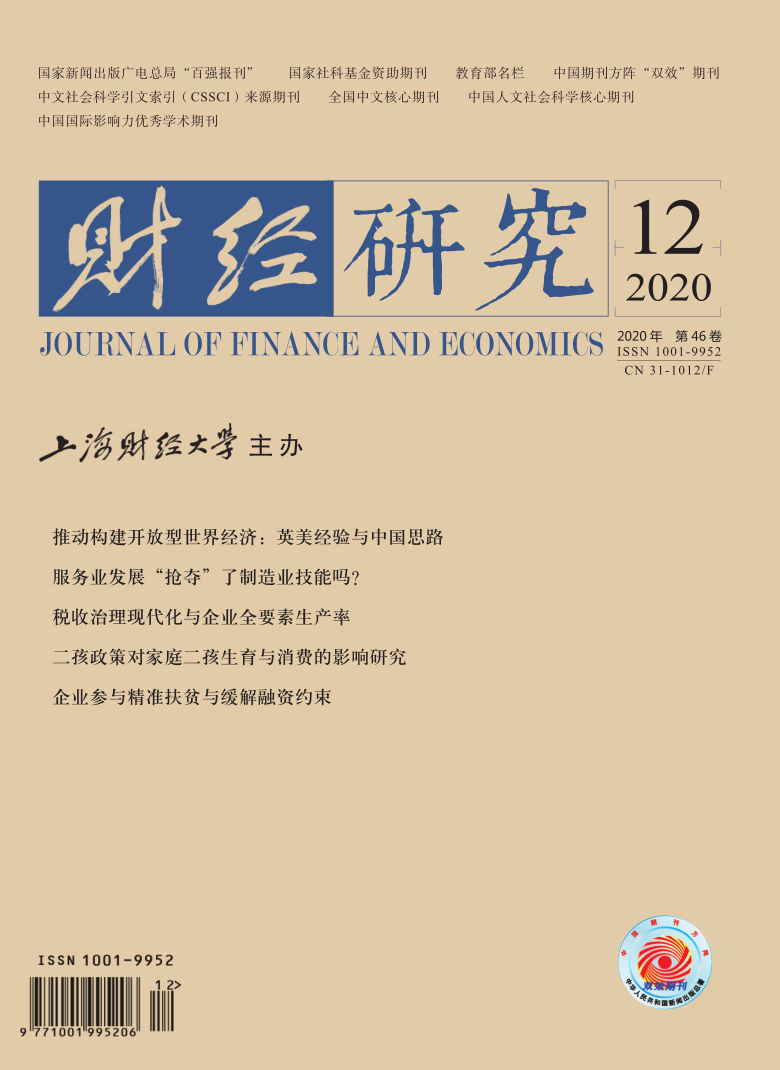文章基于服务产品跨地域运送更加便利的特性,重新构建了城市可利用服务业发展指标,并利用经济普查数据库中技能细分劳动力信息,考察了服务业发展对制造业企业技能结构的影响,提出并证明了服务业发展所产生的“分工效应”和“竞争效应”,从生活品质的角度进一步证明了“竞争效应”的内在逻辑,并提出克服“竞争效应”的可行方案。研究发现,对于制造业服务化程度越高的行业中的企业,服务业发展对其技能结构的负面影响越强。这一负面影响既表现在制造业企业通过引入专业中间服务品,促使分工深化,使得技能劳动力从制造业自然流出,即服务业发展的“分工效应”;也表现在服务业发展与制造业在劳动力市场上形成人才竞争,带来制造业企业技能劳动力的非自愿短缺,即服务业发展的“竞争效应”。进一步的研究表明,生活品质对技能劳动力就业有显著影响,城市公共服务和生活服务供给水平的提升有助于缓解服务业发展的“竞争效应”。文章的研究结论意味着推动服务业和制造业的融合发展,促进专业服务产品进入制造业产品分工是解决我国劳动力市场供需结构性不匹配,防范潜在的“产业空心化”问题的关键举措;同时在制造业转型升级关键期,政府通过公共产品提供和基础设施配套是帮助制造业企业吸引技能劳动力,保持竞争力的可行方案。
服务业发展“抢夺”了制造业技能吗?——来自中国微观层面的经验证据
摘要
参考文献
5 江静,刘志彪,于明超,等. 生产者服务业发展与制造业效率提升:基于地区和行业面板数据的经验分析[J]. 世界经济,2007,(8):52−62. DOI:10.3969/j.issn.1002-9621.2007.08.006
12 郑思齐,符育明,任荣荣. 居民对城市生活质量的偏好:从住房成本变动和收敛角度的研究[J]. 世界经济文汇,2011,(2):35−51. DOI:10.3969/j.issn.0488-6364.2011.02.003
13 Amiti M,Wei S J. Service offshoring and productivity:Evidence from the US[J]. The World Economy,2009,32(2): 203−220. DOI:10.1111/j.1467-9701.2008.01149.x
14 Baines T,Lightfoot H,Smart P,et al. Servitization of manufacture:Exploring the deployment and skills of people critical to the delivery of advanced services[J]. Journal of Manufacturing Technology Management,2013,24(4): 637−646. DOI:10.1108/17410381311327431
15 Bresnahan T F,Brynjolfsson E,Hitt L M. Information technology,workplace organization,and the demand for skilled labor:Firm-level evidence[J]. The Quarterly Journal of Economics,2002,117(1): 339−376. DOI:10.1162/003355302753399526
16 Buera F J,Kaboski J P. The rise of the service economy[J]. American Economic Review,2012,102(6): 2540−2569. DOI:10.1257/aer.102.6.2540
17 Chen Y,Rosenthal S S. Local amenities and life-cycle migration:Do people move for jobs or fun?[J]. Journal of Urban Economics,2008,64(3): 519−537. DOI:10.1016/j.jue.2008.05.005
18 Crinò R. Service offshoring and white-collar employment[J]. The Review of Economic Studies,2010,77(2): 595−632. DOI:10.1111/j.1467-937X.2009.586.x
19 Falk M,Wolfmayr Y. Services and materials outsourcing to low-wage countries and employment:Empirical Evidence from EU countries[J]. Structural Change and Economic Dynamics,2008,19(1): 38−52. DOI:10.1016/j.strueco.2007.12.001
20 Gabriel S A,Mattey J P,Wascher W L. Compensating differentials and evolution in the quality-of-life among U.S. states[J]. Regional Science and Urban Economics,2003,33(5): 619−649. DOI:10.1016/S0166-0462(02)00007-8
21 Kahn M E. Smog reduction’s impact on California county growth[J]. Journal of Regional Science,2000,40(3): 565−582. DOI:10.1111/0022-4146.00188
22 Kaiser B,Siegenthaler M. The skill-biased effects of exchange rate fluctuations[J]. The Economic Journal,2016,126(592): 756−780. DOI:10.1111/ecoj.12376
23 Kalemli-Ozcan S,Sørensen B E,Yosha O. Risk sharing and industrial specialization:Regional and international evidence[J]. American Economic Review,2003,93(3): 903−918. DOI:10.1257/000282803322157151
25 Silvanto S,Ryan J,McNulty Y. An empirical study of nation branding for attracting internationally mobile skilled professionals[J]. Career Development International,2015,20(3): 238−258. DOI:10.1108/CDI-08-2014-0105
26 Wiswall M,Zafar B. Preference for the workplace,investment in human capital,and gender[J]. The Quarterly Journal of Economics,2018,133(1): 457−507. DOI:10.1093/qje/qjx035
引用本文
铁瑛, 崔杰. 服务业发展“抢夺”了制造业技能吗?——来自中国微观层面的经验证据[J]. 财经研究, 2020, 46(12): 19-33.
导出参考文献,格式为:






 5461
5461  10579
10579

